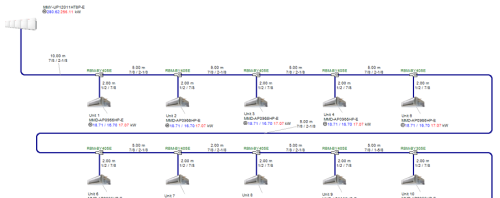19 August 2021
|
There was a time, in the not too distant past, that electrical heating was frowned upon and passing Part L of the compliance guide seemed to lead us to gas. Times have changed, and swiftly. In a relative bat of an eye, the electrically driven refrigeration cycle, in the form of heat pumps, has risen to prominence.
However, has our mentality reacted as swiftly?
As our clients, perhaps throughout all their career, have reached for a boiler, water pipe sizing chart and pump selection information, a re-think may be needed. The temptation is to keep everything the same but `swap` the boiler for an ASHP, accepting perhaps the reduced supply temperatures and hoping the power is available. We then keep the wet system `mentality` as we always have.
There is an opportunity to adjust the core approach on smaller applications.
VRF is very efficient, often more efficient than ASHP, especially in part load (we spend most of our days in part load, nearly all in fact). Refrigerant pipework is relatively small compared to insulated water pipework, indoor and outdoor units match exactly, and controls have developed such that commissioning is swift and self-addressing.
Example 1 (warehouse)
A 250kW heating only load in a warehouse has not been, until now, a natural VRF application. Boiler (manufactured by Company A) and blower heaters perhaps the traditional choice (Company B), pumps and ancillaries (Companies C, D & E) all linked with a control panel (Company F). Items collated, piped, insulated and power/control wired by the mechanical contractor.
The temptation is to simply replace the boiler, keep with the concept, and install an ASHP with possibly reduced flow/return temperatures.
Reminder: 2 major items impact on ASHP efficiency.
• Air on temperatures. Colder the air on, less efficient the ASHP, especially sub zero oC
• Water temperatures. Higher the flow temperature, less efficient the ASHP.
VRF 2-pipe can deliver up to 250kW (*Toshiba SHRMu) in a single matched system using large ducted indoor units. All items to create heat from a single source. Largest pipe 2 1/8 ” outside diameter (pre insulation).
Example 2 (business park unit offices)
Six no office areas within a factory/business park with primarily a heating only load of 15kW per area. Again, a boiler with wet system would be the norm, having radiators in each office and an element used for domestic hot water in toilets/kitchen.
With the gas phase out, air cooled split system heat pumps now become a reality. Selected on heating yet having comfort cooling as a welcome biproduct in the summer months at no extra capital cost. Water heating by over-sink electric.
Summary
The major shift in heating source for heating allows us an opportunity to review our base core habits. ASHP are superb for a myriad of applications. Underfloor & trench heating specifically as the water temperatures are much lower than the `old` gas water temperatures. Some applications, though, once automatically approached with `boiler & rads` on water flow temperature of circa 80oC, can be delivered with air-to-air heat pumps (VRF & splits), rather than air-to-water ASHP.

Design in Detail is sponsored by Cool Designs Ltd.








